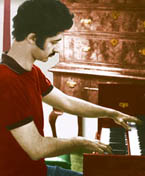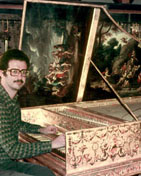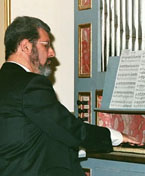Biography
Italian, born in Buenos Aires, Argentina, Claudio Di Veroli received his training from a distinguished group of European musicians: Ernst Epstein (piano and interpretation), Erwin Leuchter (harmony) and Ljerko Spiller (chamber music). Living in Europe in the early 70's he studied the harpsichord with Colin Tilney in London and Hubert Bédard in Paris. He was granted access and practised extensively on the antique keyboards in the Fenton House (London) and the Paris Conservatoire's Musée Instrumental (now Musée de la Musique). With a PhD in Mathematical Statistics from Imperial College London, he went back to Buenos Aires, where he was founder member of chamber ensembles and pioneered the performance of Baroque music based on ancient practices.
Having adopted early tuning systems, he has been the first harpsichordist to use Baroque fingerings throughout his public performances. Di Veroli has carried out extensive research in the interpretation of French Baroque music, historical keyboard fingerings and unequal temperaments, often applying advanced scientific and computer tools. His writings have been endorsed in writing by leading musicians and musicologists such as Gustav Leonhardt, Igor Kipnis, John Barnes, Patrizio Barbieri and others. They include four favourably-reviewed books (on tuning and temperament, baroque keyboard technique and baroque keyboard interpretation), several editions of harpsichord music with baroque fingerings, and many published papers, most recently in Harpsichord & fortepiano (UK).
Considered a leading harpsichordist and specialist in Baroque interpretation in South America, he has been Professor of Harpsichord and examiner of the Organ course at the Conservatorio Nacional in Buenos Aires. Recent teaching practices include short courses and masterclasses in Uruguay, Argentina, Italy and Ireland.
As a soloist—mostly on the harpsichord but also on the organ—Di Veroli has performed extensively in all types of venues: concert halls, churches, radio and TV, both solo and with ensembles, with very favourable reviews in leading newspapers. His last public performance before leaving Argentina was the final recital of the 2000 season at the Baroque Organ in Buenos Aires Cathedral. In 2001 Di Veroli moved to Ireland, where he is musical director of Bray Baroque. His most recent recitals have been on his French two-manual Hubbard harpsichord based on Taskin. Lately he has moved to Lucca, Tuscany, Italy. He is currently the Administrator of the Facebook group “Early Music Performance Practice”.
Published Articles
(in reverse chronological order: links are included for all the articles available online)
“L’Art de Toucher le Clavecin” for the modern performer. English updated version of the article published in Italian in 2016 in the website La Sala del Cembalo. Lucca, 2024.
“Forkel, Bach and anonymous clavichords” in Harpsichord & fortepiano Vol. 28 no. 2, pp. 8-9, Worcester UK 2024.
“Forkel’s Bach revisited” in Harpsichord & fortepiano Vol. 27 no. 2, pp. 12-19, Worcester UK 2023.
“1741: Three Masterworks of Diversity” in Harpsichord & fortepiano, Vol. 26, no. 2, pp. 21-26, UK 2022.
“Performing François Couperin's Les Baricades Mistérieuses” in Harpsichord & fortepiano, Vol. 24, no. 2, pp. 15-19, UK 2020.
“Baroque Keyboard Fingering and Present-Day Practice” in Harpsichord & fortepiano, Vol. 23, no. 2, pp. 27-34, UK 2019.
“Accurate meantone tuning based on Fogliano” in Harpsichord & fortepiano, Vol. 23, no. 1, pp. 16-20, UK 2018.
“A measured approach to J.S. Bach's Stylus Phantasticus” in Harpsichord & fortepiano, Vol. 21, no.2, pp. 17-26, UK 2017.
“A concise account of historical harpsichord ranges” in NEMA (National Early Music Association UK) Newsletter Vol. i/1, Univ. of Cambridge UK 2017.
“L'Art de Toucher le Clavecin e l'interpretazione filologica” (L'Art de Toucher le Clavecin and authentic interpretation) in La Sala del Cembalo, Rome 2016.
“A harpsichordist's reappraisal of Haney's Harpsichord magazine” in La Sala del Cembalo, Rome 2016.
“Clavicembali Espressivi” (Expressive Harpsichords) in La Sala del Cembalo, Rome 2016.
“Optimising Harpsichord Staggering” in Harpsichord & fortepiano, Vol. 16, no. 2, pp. 8-13. UK 2012.
“Restringing the Hubbard-Di Veroli Harpsichord”. WWW. Bray Baroque, Bray, Ireland, Apr. 2011 .
“Taskin Harpsichord Scalings and Stringings Revisited”. WWW, Bray, Ireland 2011.
Harpsichord – Fitting a singing buff. Bray Baroque, Bray, Ireland 2011. WWW .
“Cembalo: Decadenza e Rinascita” (Harpsichord: Decadence and Revival) in La Sala del Cembalo, Rome 2011.
“Unequal Temperaments: Revisited” in The Viola da Gamba Society Journal, Vol. Four, pp. 164-182, UK Jan. 2011.
“Vallotti as the Ideal German Good Temperament” in Harpsichord & fortepiano, Vol. 15, no. 1, pp. 9-14. UK 2010.
“A Concise Guide to the Most Useful 12-Note Unequal Temperaments”, in Chapter 8 “Unequal Temperaments, § Selecting Temperaments for Historic Authenticity”, pp. 93-107 of The Veritune 100 User Guide, Veritune, Chicago 2003.
“Tuning the témpérament ordinaire” in Harpsichord & fortepiano, Vol. 10, no. 1, pp. 22-29. UK 2002. (1)
“Disposición original del órgano colonial de la Catedral Metropolitana de Buenos Aires” in Música e Investigación, Revista del Instituto Nacional de Musicología Carlos Vega, Año 4 Numero 7-8, Buenos Aires 2001. An English translation is available as “The original specification of the colonial organ in the Metropolitan Cathedral of Buenos Aires” in Academia.
“Inégalité and Rameau's Concerts: a case of Ille Dixit?” in Harpsichord & fortepiano, Vol. 8, no. 2, pp. 28-34. UK 2000. (3)
“Base de Datos de Organos de la República Argentina” (Database of the Pipe Organs in Argentina) in VI Encuentro Latinoamericano de Organistas y Organeros, Buenos Aires 1998.
“Early Keyboards in Argentina” in Harpsichord & fortepiano, Vol. 6, no. 2, pp. 20-21. UK 1997.
“Did Couperin ever play a trill before the beat?” in Harpsichord & fortepiano, Vol. 6, no. 1, pp. 20-22. UK 1997. (3)
“El Temperamento Musical Ayer y Hoy” (Musical Temperament, Past and Present) in Boletín de Música Antigua I/1 pp. 3-8, I/2 pp. 3-7 and I/3 pp. 3-8, Collegium Musicum, Buenos Aires 1996. An Italian translation is available as “Il Temperamento Musicale Ieri e Oggi” in Academia.
“Un temperamento francés de 1690: eslabón perdido entre la entonación media y el temperamento circular francés del siglo 18” (A French temperament of 1690: a link between meantone and 18th Century's French circular temperaments), with Sylvia Leidemann, in Segundas Jornadas Argentinas de Musicología, Buenos Aires 1985. (1)
“Bach no fue clavicordista ni pianista” (Bach was neither a clavichordist nor a pianist) in Mediante IV/7 pp. 4-7. Conservatorio Nacional Superior de Música, Buenos Aires 1985. (3)
“Early Harpsichord Fingerings: experiences in Research, Practice and Teaching”. International Symposium on the Lute and Ancient Music, Buenos Aires 1984.
“Esperienze nella ricerca, uso ed insegmanento di diteggiature antiche sul clavicembalo” (Experiences in research, use and teaching of early fingerings on the harpsichord), in the Riunione Il Liuto e la Musica Antica, Buenos Aires 1984. (2)
“Interpretación de Tresillos y Dosillos en la Música de J. S. Bach” (Performing Triplets and Duplets in the music of J.S. Bach) in Primeras Jornadas Argentinas de Musicología, Buenos Aires 1984. (3)
“Wanda Landowska está desacreditada” (Wanda Landowska is discredited) in ProMusica, No 13 p. 31, Buenos Aires 1983.
“Toccata y Fuga en re menor para órgano de Bach, o el Juego de los Cuatro Errores” (Toccata and Fugue in d minor for organ by Bach or the Puzzle of the Four Errors) in ProMusica, Annual'82, p. 13, Buenos Aires 1982.
“Bach's temperament” in Early Music vol. 9 pp. 219-221. UK 1981. An Italian translation is available as “Il Temperamento di Bach,1981” in Academia. (1)
“El Clave: Historia y Resurgimiento” (The Harpsichord: History and Revival) in FICTA I/1, pp. 41-61. Buenos Aires 1976. (3)
____________________________
(1), (2), (3): This article was later fully revised and updated, and is now part of a book:
(1) Unequal Temperaments: Theory, History and Practice, 5th ed., 2021.
(2) Baroque Keyboard Fingering: a Method, 8th ed., 2020.
(3) Playing the Baroque Harpsichord, 4th ed., 2022.




